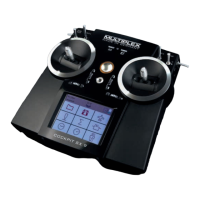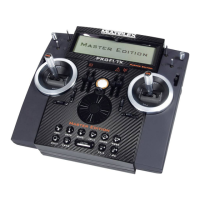ROYAL SX
6
Timers for total transmitter operating time and
model operating time (model-specific)
Programming
Clearly designed, efficiently structured menus for
simple programming
Optional keypad or two 3-D digi-adjusters for pro-
gramming
Clear text menu system, screen texts can be dis-
played in various national languages
Model-specific settings
Flight phase switching
With up to four flight phases for fixed-wing models
and helicopters, variable transition time
Dual-Rate and Expo, variable for each flight phase
separately
Five-point servo adjustment
Servo travel right / left, centre and two intermediate
adjustment points allow compensation for linkage
inaccuracies and mechanical travel discrepancies
Three timers (slot, sum, interval)
With variable alarm time and audible alarm
Separate timer for the model’s total operating time
Convenient model memory management
Unrestricted model names, up to sixteen charac-
ters, copy and erase functions
Comprehensive set-up and mixer facilities for
fixed-wing model aircraft and helicopters
Eight model templates cater for many different
model types and help to minimise the program-
ming effort required
Differences between transmitter versions:
We are confident that you will rapidly learn to appreciate
your ROYAL
pro
once you have taken a little time to
familiarise yourself with its facilities. These operating
instructions are intended to guide you through this
process. The system will give your endless hours of
pleasure in our mutual and fascinating hobby of model
sport.
Yours - the MULTIPLEX team
2.1. The ROYAL SX philosophy
At the design stage of the ROYAL SX we placed par-
ticular emphasis on high-level user-friendliness, flexi-
bility and maximum standardisation.
The user-friendly aspect results from the clearly ar-
ranged menu structure, the informative and well laid-
out menus and the large number of useful “little
touches” which make it easier to program and use the
transmitter.
The transmitter’s flexibility is due to a combination of
two features: the large number of facilities which are
pre-defined and ready to use, and the ability to vary
almost all of them exactly as you wish. Transmitter
controls (sticks, sliders and switches) and servos can
be assigned without restriction, and the pre-defined
mixers can be modified in any way you like.
You can create your own “standard” by fine-tuning the
pre-defined mixers and assignment lists to suit your
personal preferences and applications.
Standardisation makes it easier and more intuitive to
program the transmitter. Pre-defined model templates,
mixers and assignment lists ensure that you can set
up a new model memory with just a few button-
presses, and it is then ready for immediate use.
Chapter “11. The ROYAL SX philosophy” describes
the background to the system and related facilities,
and is intended to help you understand the way the
transmitter works. It is therefore particularly important
to read this section.
2.2. Arrangement of the instructions
In addition to other subjects, Part 1 (Chapters 1. to
10.) contains important information on the subject of
safety !. This section also includes all the informa-
tion you need concerning the transmitter’s hardware.
Essential reading!
Part 2 (Chapter 11.) concentrates on the HOW and
WHY of the ROYAL SX’s wide-ranging software func-
tions. This background information makes it much
easier to understand the sequence of operations
when programming the transmitter.
Part 3 and Part 4 describe step by step how to pro-
gram a fixed-wing model aircraft and a model heli-
copter.
First the basic functions (aileron, elevator, rudder,
throttle / collective pitch, roll, pitch, yaw) are “brought
into play”.
After this the text explains the essential steps required
to expand and refine the model’s functions.
Part 5 contains a detailed description of all the
menus, the model templates, the default transmitter
control settings, the switch assignments and much
more.

